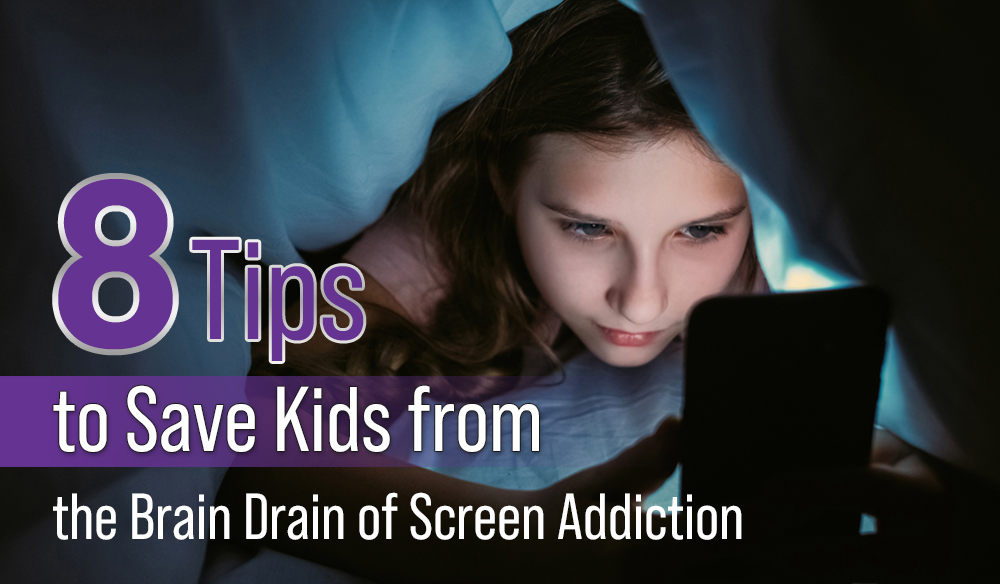8 Tips to Save Kids from the Brain Drain of Screen Addiction
Psychologists, doctors, and even many TED Talkers agree on one thing. They’ve been banging the drum for years about the dangers of too much time spent with screens and the “scroll.”
As moms, we know the lure of that hand-held glow as more information surfaces about its ill effects on young minds. What are we supposed to do? With the deceptive draw toward excessive gaming, social media, and those 15-second dopamine hits, it’s up to us to set the boundaries in our families with their health and safety in mind.
Our kids beg for their own connection to the internet and claim all their friends have phones. Maybe it’s time to dust off the old saying from our moms’ generation: “If all your friends were jumping off a cliff, would you?” Classic.
Without our loving boundaries, our own kids could quickly become part of the dismal statistics that reflect a less-engaged, more depressed, detached, and unhealthy young populace. Current data reveals that most teens are glued to their phones for over eight hours daily. That’s the equivalent of a full-time job.
Shocking.
But what about you and me? We, after all, are the ones who set the tone in our homes.
Take a second and check your screen time for today.
If you have an iPhone, go to Settings, tap Screen Time, and if you have an Android, from Settings, choose Digital Wellbeing and Parental Controls.
Go ahead, I’ll wait.
For me, it showed more than eight hours. How about you? Sure, I listen to music and podcasts – and conduct research there. However, there may also be a moment or two spent with Austin the Butler. Homescapes, anyone?
As much as we may rationalize why it’s okay for us as grown-ups, some of us would have to admit that we are pretty tied to devices almost every waking moment. Notice I said, “Some of us.” For those who have this beast under control – my hat is off to you.
For the rest of us – we can do better for ourselves and those we love.
Screens Cost Kids Plenty
While there are plenty of good things about having the world at our fingertips with today’s technology, there’s a price kids pay for too much time before the blue light of iPads, laptops, gaming devices, and smartphones.
The Mayo Clinic shared that children suffer a shortened attention span, obesity, learning and speech delays, and behavior problems – just some of the pitfalls they list in an article on their website.1 Replacing human interaction with a device can cause children to lose precious social and relational skills – with some tweens and teens seeming unable to look you in the eye and carry on an in-depth conversation.
Our guest on this week’s podcast, author and speaker Melanie Hempe, says it causes “accelerated cortical thinning and lower microstructural integrity.” That’s brain damage, folks.
Melanie’s son became addicted to gaming as a teen. His obsession went with him to college and caused him to flunk out simply because he couldn’t put down the game controller and go to class. Thankfully, after a stint regaining his life in the military – he returned home, re-entered college, and is a lawyer today. Melanie founded ScreenStrong4 to “help parents prevent screen addiction, rescue their kids, and enjoy family life again.” Don’t miss this enlightening conversation if you’re wondering where to begin with your family.
We’ve got several ideas to consider as you rethink the tech strategy for your family.
1. Stall, Postpone, and Procrastinate
Put off giving your little ones phones, laptops, or tablets as long as possible. The later, the better. There’s no rush to put an addictive device into their hands. Could you wait until high school? Your tween will survive and probably thrive – though there may be a little eye-rolling. Check out options like Gabb and Pinwheel to stay connected, which offer phones that only allow calling or texting without internet access. Stalling – postponing – and even a little good old-fashioned procrastination could protect your kids’ mental health. Instead, foster creativity – and activity.
2. Be the Example
Pulling back on your screen time may take some work and decisive action. Put down the phone when you’re with your kids and give them undivided attention. They will flourish with parents who listen and engage. The non-distracted time together will deepen your family relationships, and maybe they’ll develop good relational habits by mirroring your good example when they one day manage their own phone.
If you’re addicted and can’t imagine how to draw down the hours spent with your own screens, you can be honest about the struggle with your kids. Especially if they are tweens or teens, talk with them about your own battle in this area and why it’s essential for everyone in the family to rethink their relationship with all forms of tech.
3. Cultivate Interests and Talents
As you pull back from screen centrality, how about digging in as individuals and a family to pursue interests like gardening or pickleball. Maybe it’s time to pull out the palette or piano and refresh your music and art skills. I’ll curl up with a good novel and be happy as a clam.
Challenge your kids to rediscover old non-screen related interests, and then encourage them to try something new. One of our daughters was crazy about dogs, so we packed up the family and went to dog shows and other canine-related events during her tween and teen years. It was fun and helped her grow in her passion. Now, she thrives in her career as an animal behaviorist.
4. Get Moving
Don’t let the grass grow under your family’s feet. Grab the kids and go on a hike, ride bikes together, or try golf or tennis. Take a weekend trip, plan a scavenger hunt, go to the lake, or try a getaway to a historic site. How about indoor rock climbing? Or maybe hit the slopes (if you have slopes where you live… and snow). Physical activities bring laughter, a closer bond, and fun memories.
Another way to get the family off the couch that doesn’t require sporting skills or the price tag of a week in Aspen is to create a family culture of volunteering and service. It will boost your kids’ character and teach them empathy for others. Your family can serve at the local mission, a food pantry, or with your church.
We tend to be homebodies in our family. We like being together and often have to remind each other that it’s easier not to do something than to make an effort to get out there. It takes some rallying of the troops – but we never regret working and playing together.
Plan and go on family adventures whenever possible in your community or in the wild. Make sure everyone is engaged and set the screens aside to live life together.
5. Be the Cool House
It’s noisy, unpredictable, and sometimes messy, but it’s worth it!
Invite your kids to bring their friends to your house. Hosting no-phone fun is a great way to foster relationships and activities for them while getting to know who your kids are spending time with.
Buy a few pizzas, and… it begins. Host a game night, art night, or even a movie night. Sure, it’s a screen, but it’s also social in that setting. Enjoying a couple hours in your rec room with a fun and uplifting movie is a great way to bring kids together, with plenty of time for talking and hanging out!
6. Know and Love the Limits
The Mayo Clinic recommends kids under 18 months have no screen time (other than a Zoom call with Grandma). Then, ages 2-5 should limit it to an hour, and they recommend something educational or “high-quality.”
In a TED Talk Adam Alter gave several years ago, he lamented the loss of what he called “stopping cues.” 2 At the end of a book or a magazine, we stop. When we do a crossword puzzle in the newspaper – it has a natural endpoint. Even when we watched TV (before streaming brought the binge), we viewed an episode and had to wait a whole week before the story picked up again. In many ways, we took those stopping cues for granted – and now, scrolling through social media and YouTube videos – we see that there are no natural endpoints, as the algorithms serve us up an unending stream of more of the same.
It’s up to us, Mamas, to set the limits we deem appropriate, and we suggest that you create your own “stopping cues,” which may involve a clock or timer. Ensure the whole family is committed to the plan, with parents setting solid examples for the kids.
7. Create No-Tech Zones
For some, it’s not tech at the dinner table. Others make bedrooms phone and device-free after a particular hour, like 7 pm, giving teens the chance to unwind mentally from social media stress.
Where else would a no-tech zone make sense for you?
8. Teach Your Teens About Screens
Rules are one thing, but sharing stories from the news, data, and even Ted Talks on the subject is important. That way, as your young people approach adulthood, they’ll be armed with the facts about the impact screens and social media have on each of our lives.
Dino Ambrosi gave an eye-opening example of the cost of centering life around the screen in his TEDx Talk.3 He showed an amazing graphic using data about how Americans spend their days and hours. Removing the givens like sleep, school, career, eating, bathroom trips, and driving, he illustrated the loss of more time based on the average 18-year-old’s screen time. Then the chart showed what was left in “free time” if a person lives to 90. The remainder after the time suck of devices – time for things like travel, reading, enjoying friends and family, and bucket-list items was a startlingly small number of months.
His vivid point was that if a person continues on their screen addiction trajectory – it’s stealing their very lives. I recommend sharing that talk with your teens. (The link is at the end of this article.) It’s eye-opening.
Dino explained that social media has a “business model that has incentives which are fundamentally misaligned with your wellbeing. Because you are the product that social media sells. These services are free because they are monetizing you. They profit by helping advertisers change your future behavior, whether that be where you spend your time, how you spend your money, or even who you vote for.”
ScreenStrong also offers an assessment and courses that can help educate your family.4 There are so many alarms sounding, and thankfully, there are a growing number of resources to help.
More to Consider
Regardless of how you handle this season in your family, one day, your kids will be adults who will inevitably navigate screens and the Wild West of the internet for themselves. For this blog post, we won’t be able to go into the tragic stories of kids lured into the transgender lifestyle and others who suffered at the hands of criminals they met online. There are plenty of schemes and scams, pornography, sextortion, and cyberbullying in this dangerous online world for impressionable tweens and teens.
Your standards, limits, and vigilance can protect your kids from online lures and deceptions. Care and boundaries can refocus your child on activity, learning, and developing deep relationships. Without addiction to a smartphone or tablet, they can dream, adventure, and embrace a standard of screen sanity that will help them as they enter adulthood – and have their own kids. It’s not a stretch to conclude that you are saving – and giving them back, their lives.
2 ted.com “Why Our Screens Make Us Less Happy”
3 youtube.com “The Battle for Your Time: Exposing the Costs of Social Media”
***




